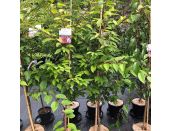Handsome, conical tree grown for its glossy, maple-like summer foliage that turns brilliant crimson, purple and orange during autumn
Older stems have corky bark giving year round interest
Non-evergreen
Ideal specimen tree or windbreak for sheltering exposed and larger gardens
12 litre pot
Height x Spread up to 10m x 6m
We are delivering locally at £5.00 to the following postcode areas:-
RH1, RH2, RH3, RH4, RH7, RH8, RH9, TN8, TN16, CR3, CR5, CR6, KT20.
We are delivering locally at £7.50 to the following postcode areas:-
CR2, CR8, RH6, RH10, RH11, RH18, RH19, BR6, TN7, TN13, TN14, KT18, SM7.
We are delivering locally at £10.00 to the following postcode areas:-
BR2, BR4, SM5, CR0, KT21, KT22, KT23.
Write a review about "Liquidambar Styraciflua (Sweet Gum)"
We want to know your opinion! Write a review about the product “Liquidambar Styraciflua (Sweet Gum)” and win a National Gardening Gift Voucher of £25 !
If you are looking for more information about this product, please visit our garden centre in Surrey where our friendly and knowledgeable staff is ready to help you. Please visit our contact page to see our opening hours.
Our address:
Knights Nags Hall,
Oxted Road,
Godstone, Surrey, RH9 8DB
Knights Plant Centre,
Station Road,
Betchworth, Surrey, RH3 7DF
Our staff are ready to help and happy to answer all your questions to help you to make the right choice, so pop in-store now. We look forward to seeing you soon.
Frank P Matthews
Tree Care Tips
Thank you for buying one of our trees, grown in the fertile Teme Valley in Worcestershire
1.Planting
Dig a hole roughly twice the size of the pot and back fill with some general purpose compost. We recommend also using our ‘rootgrow’ ™ planting partner to aid establishment. The top of the soil in the pot should be at about ground level. Water well and firm in, making sure there are no air pockets. If the tree is in an exposed site use a stake and tie to keep it steady for the first few years whilst it gets established. And if there is any danger of rabbits then put a guard around the trunk or they may strip the bark and harm the tree!
2. Watering
Young trees will need to be watered in the first season, especially if planted in the spring. A full watering can twice a week will help the tree put strong roots down, more if the weather is dry. Trees planted in the autumn should require less watering as the roots will have had the winter to settle in. If your tree is to be kept in a container then more frequent watering is likely to be necessary, especially in hot weather.
3. Feeding
Trees do not need fertiliser unless the soil is particularly poor or they are being kept in a container. If so, our Natural Tree Feed Liquid Concentrate applied in February or March before spring growth is ideal.
4. Mulching
A good mulch of bark chippings around the base of the tree will reduce competition for nutrients from grass and weeds and make the tree healthier and stronger. A circle of mulch covering at least a foot from the base is perfect. Do not apply weed killers such as glyphosate around young trees as it could kill them!
5. Pruning
We will have done all the necessary formative pruning on your tree. Many trees, including ornamentals, can be pruned hard in winter to reduce their size, check the colour label or our website for more information. Apples and pears can be pruned at any time of year; stone fruit, e.g. plums and cherries, are best pruned in late summer. Pruning off tips in late June/early July will encourage flower and fruit buds the following year; winter pruning encourages more vegetative growth. Trained fruit trees (especially step overs and espaliers) should have vertical growth pruned back regularly. Prune off unproductive ‘feathers’ (lower shoots) on fruit tree stems and remove any suckers that may appear from the base.
6. Fruit Thinning
Modern varieties, especially on dwarf rootstocks, set heavy crops and should be thinned in late June (much of the fruit will self thin by this time). During the first year of planting it is best to remove most of the fruit to allow the tree to put energy into producing strong roots and branches. This may need to be extended into the second year if the tree has not made reasonable extension growth. Leaving a few to taste is fine! Fruit in direct sunlight will gain the best colour.
7. Pest and Disease
Pests will affect trees from time to time and can be tolerated in small amounts as they do no harm. They generally appear on the undersides of the leaves so always turn leaves over for early detection! Severely affected leaves can be removed by hand on young trees. Most varieties offered will have some tolerance of diseases such as scab and mildew and the worst effected fruits can be removed when fruit thinning, always bin or burn affected leaves and rake up any in the autumn. Prune off any dieback to good wood with clean secateurs.
For more advice and information visit www.frankpmatthews.com

